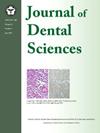Human umbilical cord mesenchymal stem cells secretome and nanoemulsion propolis combination ameliorate osteoclastogenesis in lipopolysaccharide-induced osteolysis in hyperglycemia rats
IF 3.1
3区 医学
Q1 DENTISTRY, ORAL SURGERY & MEDICINE
引用次数: 0
Abstract
Background/purpose
Human umbilical cord mesenchymal stem cell secretome (HUCMSCS) and nanoemulsion propolis (NEP) from Tetragonula biroi may be beneficial regenerative medicine to reduce LPS-induced osteolysis with hyperglycemia. This study aimed to investigate the HUCMSCS and NEP effect on nuclear factor associated T-cell-1 (NFATc1), sclerostin, receptor activator kappa beta (RANK), its ligand (RANKL), the osteoprotegerin (OPG) expression, tartrate-resistant acid phosphatase (TRAPase), and cathepsin K (Ctsk) serum level in LPS-induced osteolysis in hyperglycemic Wistar rats (Rattus novergicus).
Materials and methods
Twenty-eight healthy male Wistar rats, 1–2 months old and 250–300 g body weight, were divided into seven groups, namely K1: control group; K2: 100 μl LPS; K3: hyperglycemia (≥230 mg/dL); K4: 100 μl LPS with hyperglycemia; K5: LPS, hyperglycemia, and 100 μl NEP; K6: LPS, hyperglycemia, and 100 μl HUCMSCS; and K7: LPS, hyperglycemia, and 100 μl HUCMSCS and NEP. Escherichia coli`s LPS was used to induce osteolysis on the calvaria. NEP and HUCMSCS were formulated and collected, then injected subcutaneously on the calvaria. Hyperglycemia-induced streptozotocin 30 mg/kg injection for one week, intraperitoneally. All samples were sacrificed on day 8. Blood samples were collected to examine TRAP and Ctsk levels with enzyme-linked immunosorbent assay. NFATc1, sclerostin, and RANK-RANKL-OPG expression investigated with immunohistochemistry.
Results
HUCMSCS and NEP administration inhibit TRAP and Ctsk levels, reduce NFATc1, sclerostin, and RANK-RANKL, but enhance OPG expression in LPS-induced osteolysis with hyperglycemia with significant differences between groups (P ≤ 0.05).
Conclusion
HUCMSCS and NEP post-administration reduced osteoclastogenesis in LPS-induced osteolysis calvaria with hyperglycemic in rats in the early phase of bone remodelling.
人脐带间充质干细胞分泌组和纳米乳剂蜂胶联合应用改善脂多糖诱导的高血糖大鼠破骨细胞生成
背景/目的人脐带间充质干细胞分泌组(HUCMSCS)和纳米乳剂蜂胶(NEP)可能是减少脂多糖诱导的高血糖性骨溶解的有益再生药物。本研究旨在探讨HUCMSCS和NEP对lps诱导的高血糖Wistar大鼠(Rattus novergicus)骨溶解中核因子相关t细胞-1 (NFATc1)、硬化蛋白、受体激活物κ β (RANK)及其配体(RANKL)、骨保护素(OPG)表达、抗酒石酸酸性磷酸酶(TRAPase)和组织蛋白酶K (Ctsk)血清水平的影响。材料与方法选取1 ~ 2月龄、体重250 ~ 300 g的健康雄性Wistar大鼠28只,分为7组:K1组:对照组;K2: 100 μl LPS;K3:高血糖(≥230 mg/dL);K4: 100 μl LPS伴高血糖;K5: LPS、高血糖、100 μl NEP;K6: LPS、高血糖、100 μl HUCMSCS;K7: LPS,高血糖,100 μl HUCMSCS和NEP。采用大肠杆菌LPS诱导大鼠颅骨骨溶解。制备NEP和HUCMSCS,收集后皮下注射于颅骨。高血糖诱导链脲佐菌素30 mg/kg注射,腹腔注射1周。第8天处死所有标本。采集血样,用酶联免疫吸附法检测TRAP和Ctsk水平。免疫组织化学检测NFATc1、sclerostin和RANK-RANKL-OPG的表达。结果在lps诱导的高血糖性骨溶解中,给药ucmscs和NEP可抑制TRAP和Ctsk水平,降低NFATc1、sclerostin和RANK-RANKL,但可提高OPG表达,组间差异有统计学意义(P≤0.05)。结论给药后hucmscs和NEP可减少脂多糖诱导的骨重构早期高血糖性骨溶解大鼠的破骨细胞生成。
本文章由计算机程序翻译,如有差异,请以英文原文为准。
求助全文
约1分钟内获得全文
求助全文
来源期刊

Journal of Dental Sciences
医学-牙科与口腔外科
CiteScore
5.10
自引率
14.30%
发文量
348
审稿时长
6 days
期刊介绍:
he Journal of Dental Sciences (JDS), published quarterly, is the official and open access publication of the Association for Dental Sciences of the Republic of China (ADS-ROC). The precedent journal of the JDS is the Chinese Dental Journal (CDJ) which had already been covered by MEDLINE in 1988. As the CDJ continued to prove its importance in the region, the ADS-ROC decided to move to the international community by publishing an English journal. Hence, the birth of the JDS in 2006. The JDS is indexed in the SCI Expanded since 2008. It is also indexed in Scopus, and EMCare, ScienceDirect, SIIC Data Bases.
The topics covered by the JDS include all fields of basic and clinical dentistry. Some manuscripts focusing on the study of certain endemic diseases such as dental caries and periodontal diseases in particular regions of any country as well as oral pre-cancers, oral cancers, and oral submucous fibrosis related to betel nut chewing habit are also considered for publication. Besides, the JDS also publishes articles about the efficacy of a new treatment modality on oral verrucous hyperplasia or early oral squamous cell carcinoma.
 求助内容:
求助内容: 应助结果提醒方式:
应助结果提醒方式:


